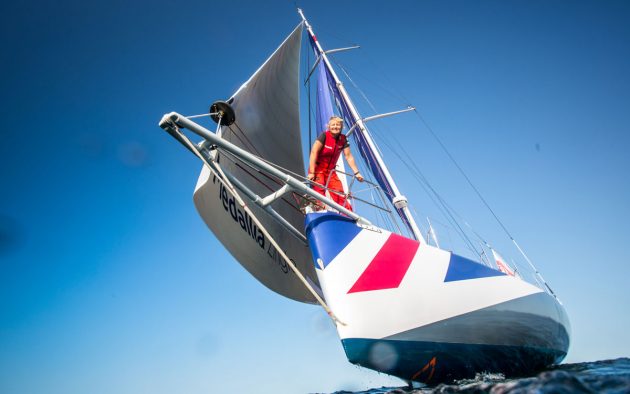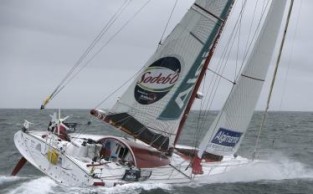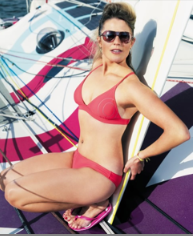Pip Hare talks to Elaine Bunting about the long road to fulfilling her Vendee dream
While many of us are wondering who we will be able to spend Christmas with this year, Pip Hare’s dream is to be isolated and alone.
Fingers crossed, the 46-year-old will be deep in the Southern Ocean.
This Sunday, on 8 November, she and 33 other solo sailors will set out from Les Sables d’Olonne in France on the Vendée Globe non-stop round the world race.
The fleet bristles with the latest foil-borne flying machines capable of reaching 40 knots, costing €10-15 million apiece.
Lined up against them, Hare will be on Medallia, the almost 20-year-old, resolutely flightless IMOCA 60 she took out a loan to rent.
Winning is out of the question. Yet no one is better placed to expose sailing’s fiercest test of survival than this determined, down-to-earth skipper.
Galvanised by the feats of Ellen MacArthur and Isabelle Autissier, Hare always dreamed of competing in the Vendée Globe.
But unlike the French sailors who dominate sailing’s ultra-marathon, or her British counterparts Alex Thomson, Sam Davies and Miranda Merron, Hare’s cruising, teaching and seamanship background put her at a disadvantage.
She had no youth squad pathway, no apprenticeship with a campaign team, no network of connections to help.
It has been a long, often confidence-sapping road.

Pip has steadily worked her way through the short-handed racing ranks, including the 2013 Mini Transat. Credit: Thierry Martinez/Sea&Co
ALL ABOUT ADVENTURING
Pip Hare grew up messing around in boats.
Her grandfather kept a clinker-built wooden Folkboat at Waldringfield on the River Deben.
Her family lived in landlocked Huntingdon but her mum and dad took their four children on sailing holidays.
‘My earliest memories are of being on that boat. I remember us sleeping on board and Mum cooking us dinner on the single burner paraffin stove,’ she recalls.
‘But it was never just about sailing; it was about adventuring. We could all swim and we could all row strongly against the tide. I didn’t think of sailing as a sport.’

Sailing for Pip (second left) was a family affair
When her parents bought a Moody 33 they started going further afield, across the Channel to France, Holland and Belgium.
‘I definitely didn’t really enjoy sailing then, it was all a bit stressy,’ she says.
But at 16 she enrolled on an RYA Young Skipper scheme and that changed everything.
Sailing out of Plymouth on Hunter Duette bilge keelers, teenagers were taught the basics of seamanship and navigation.
They made passages west to Helford. They rowed into Polperro and dried out.
‘We navigated using paper charts on our laps. It was proper sailing with a huge amount of responsibility and the freedom that you were looking for as a teenager and couldn’t find anywhere else,’ she says.
‘From then on, I was obsessed with sailing.’
She got on the water by volunteering for disabled sailing through the RYA Seamanship Foundation.
‘Racing was never an option for me.
‘The thing about the performance pathway is you need to come from a family that is able to deliver that for you.
‘Mum and Dad worked full time. It wasn’t a question of money, it was one of time.
‘They were working as hard as they could to create the life we enjoyed, so if we wanted to do stuff, we had to do it on our own.
‘We saved our own money, we cycled to the club. I worked as a cleaner, I waitressed and I saved up enough for the train fares to the south coast as often as I could.’

Pip started sailing Medallia at the start of last year and had to finish three qualifying races in 2019 to win her Vendée place. Credit: Richard Langdon/Ocean Images
At 18, she decided that she had no interest in university and ‘came home one weekend and broke my parents’ hearts’.
Her first job was as an apprentice at Victoria Sailing School in Warsash, earning £19 a week.
She taught with Sunsail before moving to the Caribbean, then New Zealand. Back in the UK, she and Laurence Hildesley, a naval architect, decided to buy an Oyster Lightwave 395 called The Shed and go cruising.
‘We started in the UK and cruised the North and South Atlantic on a tiny budget of £250 a month and when we ran out of money we would fly back and work. I lived on board for 11 of the 13 years we owned her.’
When the couple split up, Pip kept the boat and decided to sail single-handed from Uruguay to the UK to enter her first solo race, the 2009 OSTAR.
The following year she sold The Shed to buy a boat to race in the 2011 Mini Transat race from France to Guadeloupe.
The Mini 6.50s are absurdly canvassed planing 21-footers colonised by young, fearless French engineers and designers, and the traditional gateway class for the Vendée Globe.
Hare loved it. In 2013 she returned for another Mini Transat, then collided with debt and had to sell.
For the next two years, she worked in the sea safety department of the RNLI, competed in the Three Peaks Race in her spare time, running ultra-marathons and completing an Open University degree in modern languages and linguistics.
Eventually she tired of a desk job and returned to racing and coaching in Class 40s, and did the two-handed Transat Jacques Vabre from France to Brazil.

Medallia carries over 570m2 of sails. Credit: Richard Langdon/Ocean Images
FACING THE ELEMENTS
Her opportunity to do the Vendée Globe arrived almost by accident.
Late in 2018 she received an email offering her the 1999 vintage Superbigou for €2,000 a month.
She set up crowdfunding and donations came in from all over the world but a lack of confidence held her back from approaching sponsors.
‘I didn’t believe I could stand in front of a board and make a convincing case,’ she confesses.
‘I have got qualifications falling out of every folder, yet [as an RYA Yachtmaster Examiner] I’m often questioned, and it’s worse now I’m getting older.
‘I am not a hugely confident person, and never have been.
‘It has taken me a long time to realise I don’t have to listen to those people, and maybe one of the attractions of solo sailing is there is no one who is telling me I can’t do it.’
Miraculously, her sponsor came to her out of the blue during lockdown in May.
The CEO of Medallia, a global company that collects and analyses customer and employee information, is a keen sailor and had read all about her.
‘I’d been Googling ‘How do you go bankrupt?’ when I got this one-line email asking if there were any opportunities available to sponsor me.
‘Two days later I had a letter of intent and three weeks later I signed a contract,’ she recalls.
The money, a ‘six-figure sum’, came in time to do a refit and employ an experienced technical boat captain for the race.
‘But this is still a tiny project by Vendée Globe standards,’ Hare adds.
She scotches the idea that the slower boats in Vendée Globe are an adventurer section.
‘There isn’t a cruising division!’ she laughs.
In many ways, the racing is harder. Whereas on the new designs, skippers such as Alex Thomson steer from inside a cabin or cuddy and can monitor sails via remote cameras, Hare will have to confront the elements.
‘The boat has no protection outside at all, just a tiny lip that comes off the coachroof that I can sit behind. Once I step outside I am fully out in the open. Waves come down and bodyslam you, and you are up to your knees.
‘When I reef the boat I have to go to the mast. I can furl headsails from the cockpit but because I have full bulkheads not ring frames I can’t drag sails through the boat so they have to go out through hatches.’
Continues below…
Latest Vendee victim of Southern Ocean knockdown
Derek Hatfield heads for Tasmania
Singlehanded sailing for the first time
Toby Heppell looks at the art of singlehanded sailing and considers what constitutes good seamanship when it’s only you on…
Steve White to sell Open 60
Vendee Globe boat on the market
All hail Sam Davies
The folksy star of the Vendee Globe
A HUMBLE EXPLORER
While others tack their canting keels by pressing a button, Hare has to use a block and tackle taken to an electric winch.

Medallia is an older generation IMOCA 60, with little protection outside; Pip also has to go forward to the mast every time she reefs the mainsail. Credit: Richard Langdon/Ocean Images
‘I have to go down into the engine room, ease it down manually, lock it off, go back on deck, tack the boat – we get flattened coming out of the tack – then go back below and cant the keel on the electric winch.
‘Everything is harder. It takes an hour to empty the ballast tanks.
‘I sleep on the floor because there are no bunks. There is no nav station.’
In the Southern Ocean, she explains: ‘The train of lows on average moves at 25 knots and the ideal place you want to be is just ahead of the cold front, where you can position yourself in 25 knots of wind and a regular wave pattern.
‘It is glamorous sailing. But when the front overtakes you, the wind is gusting 40, the sea state sloppy, and there are breaking waves.
‘The guys at the front of the fleet can get ahead of the front and stay longer as they can cruise at 25 knots.
‘I will get overtaken and mashed up on the back of it.
‘There are not as many routing options. I will get what I am given.’
But Hare is simply explaining, not complaining.
‘I am looking forward to it. I love sailing this boat. No matter how tired and knackered I am, I’m so happy.
‘You wouldn’t be human if you didn’t get some woe-is-me creeping in there but I honestly, hand on heart, can say I can never remember not wanting to be out on the water.
‘Even when it’s really bad it’s only a moment in time.’

Like other Vendée skippers, Pip needs an intimate working knowledge of her boat. Credit: Richard Langdon/Ocean Images
Pip Hare is not a natural self-publicist, and definitely isn’t it in for the money.
‘I hope I won’t end this in debt,’ she says.
Asked if she’s still looking for crowdfunding, she says: ‘No, I closed my crowdfund as it didn’t sit with me when I got a sponsor.
‘Help someone else instead. Just follow me. Share my story.
‘The more people have heard about it the more attractive I become for a sponsor in future.’
After this race? ‘Well, I will be looking for a job, but I hope if I can finish I’ll be coming back to do the next Vendée Globe.’

Some of the volunteers who have helped Pip manage her racing campaigns. Credit: Pip Hare Racing
VENDÉE GLOBE IN A NUTSHELL
Race start: 8 November from Les Sables d’Olonne
Race favourites: Alex Thomson in his new Hugo Boss, trying to win after his 2nd place in 2016. Jérémie Beyou, on his third Vendée in the foiling Charal.
Watch for: Upstart newcomer Charlie Dalin on the superfast foiler Apivia.
Time to beat: 74 days. The winner will have to better an average speed of 13.8 knots over 25,000 miles.
How to follow: For Pip’s reports, visit: piphare.com and get videos, reports and news at: vendeeglobe.org

ABOUT THE AUTHOR
Elaine has been sailing since the age of six. A qualified RYA instructor, she has cruised throughout the UK, Ireland and the Med and has sailed across the Atlantic, Indian Ocean and Pacific. Until recently Elaine was the editor of Yachting World, where she worked for 30 years.
For all the latest from the sailing world, follow our social media channels Facebook, Twitter and Instagram.
Have you thought about taking out a subscription to Yachting Monthly magazine?
Subscriptions are available in both print and digital editions through our official online shop Magazines Direct and all postage and delivery costs are included.
- Yachting Monthly is packed with all the information you need to help you get the most from your time on the water.
- Take your seamanship to the next level with tips, advice and skills from our expert skippers and sailors
- Impartial in-depth reviews of the latest yachts and equipment will ensure you buy the best whatever your budget
- If you are looking to cruise away with friends Yachting Monthly will give you plenty of ideas of where to sail and anchor








